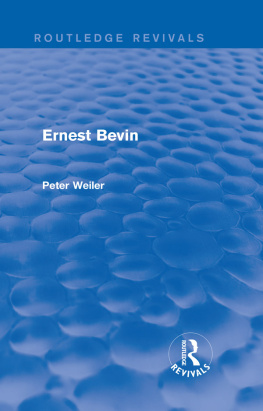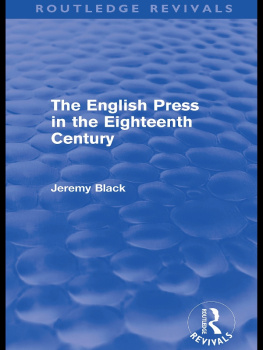First published in 1982
by George Allen & Unwin Ltd
This edition first published in 2013 by Routledge
2 Park Square, Milton Park, Abingdon, Oxon, OX14 4RN
Simultaneously published in the USA and Canada
by Routledge
711 Third Avenue, New York, NY 10017
Routledge is an imprint of the Taylor & Francis Group, an informa business
1982 E. Cashmore and B. Troyna
All rights reserved. No part of this book may be reprinted or reproduced or utilised in any form or by any electronic, mechanical, or other means, now known or hereafter invented, including photocopying and recording, or in any information storage or retrieval system, without permission in writing from the publishers.
Publishers Note
The publisher has gone to great lengths to ensure the quality of this reprint but points out that some imperfections in the original copies may be apparent.
Disclaimer
The publisher has made every effort to trace copyright holders and welcomes correspondence from those they have been unable to contact.
A Library of Congress record exists under ISBN: 82011402
ISBN 13: 978-0-415-81570-3 (hbk)
ISBN 13: 978-0-203-06618-8 (ebk)
Black youth in Britain is changing dramatically. The ferocity of purpose young blacks recently brought to their challenges at St Pauls in Bristol, Handsworth in Birmingham, Highfields in Leicester and Brixton in London, indicates not merely dissatisfaction with social conditions or disillusionment with their own positions, but a new destructive energy, an undisciplined enthusiasm for confrontation. The change in orientation is not new, nor has it been indiscernible; but it has been gestating for the last few years. Intermittent disorders at the Notting Hill carnivals and at Wolverhampton in the West Midlands (in 1978) were dispersed and then neutralised as not being racially based. But, as New Society (10 April 1980) pointed out, the establishment reaction to such occurrences revolves around the inability to see racism as a distinct variable in community relations and this reveals a depressing inability to cope with an issue which is not so much emergent as imminent.
The well-publicised riots of Bristol and Brixton, and the lesser-known incidents of Handsworth and Highfields were localised and containable. Yet they articulated genuine protests against the actions of whites generally, and the police in particular; and the outcomes of such episodes can do nothing to improve already rapidly deteriorating relationships. The unsettling aspect of it all is that black youths are vigorously contributing to the deterioration; many are consciously trying to break down what they regard as an inappropriate dependence on white society.
Young blacks in the main, whether West Indian or of West Indian descent, have been depicted as the recipients of pressure: restricted employment opportunities, police discrimination, bad inner-city accommodation, inadequate education, the whole cluster of forces emanating from white racialism. It is a familiar role for them; the episodes of early 1980 give fresh clues as to an alternative. There is a much more active part for the black youth to play now that the pattern has begun to form; and the possibility must now be faced that a sequence of events resembling Bristol and Brixton may spiral into an ugly complex of unrest and disorder.
The Bristol occurrence was generously covered by the media, but further perspective can be gained from events which followed it in Birmingham and Leicester on 5 May and 28 July 1980 respectively. In Birmingham, the affair started after a break-in at a store. The intruders were described to the police by the proprietor, and two patrolling police officers acted on the description and apprehended two black youths who were, it seems, known to them. Strong resistance was offered by the youths who were assisted by some other young blacks in beating up the police officers (one suffered a broken collar-bone and smashed ribs). The affray attracted the attention of passers-by, one of whom alerted nearby Thornhill Road police station. When police arrived to rescue the distraught officers, they were met by a hail of bricks and their presence stimulated more violence. The two policemen were eventually recovered, both unconscious.
Because they were known to the police, the suspected youths were traced to an address from where they were later picked up and taken to Thornhill Road police station. What followed was one of the most striking scenes of collective black endeavour in Handsworth since the National Front rally of 1977. An estimated two hundred black youths congregated at the police station and demanded the release of the two. The reception area filled and threats multiplied as the station was besieged. An additional seventy police officers were recruited from surrounding areas. Negotiations were hastily conducted between spontaneously appointed black spokesmen and the stations senior police officer. The crowd was eventually dispersed and order was restored: the two young blacks were granted bail.
The episode did not escalate into anything like the Bristol proportions, but it had similar ingredients nevertheless: the precipitating assault on the police officers after the apprehension of the two black youths under suspicion; the effective mobilisation of some two hundred black youths in reaction to the perceived injustice; the willingness of the police to compromise (as they did in a different way in Bristol) when faced with what was obviously a forceful threat; and crucially, the blacks perception of their own effectiveness in imposing their wishes on a collective basis. They did get something done; a tangible result was achieved which would not have been possible had they approached the matter in a less direct way.
In one sense, the issue is disappointing for the Handsworth community whose police force had prided itself on a steady improvement in its relations with black youth since the beginning of 1978 when foot-patrol officers were reintroduced in a creditable attempt to cultivate personal links with the rest of the multi-ethnic community. The changes in policing were made after the publication of the notorious and distorted Shades of Grey (1977) report which presented an apocalyptic vision of the area poised on the brink of unrest what one provincial newspaper, in a review of the report, called a powder keg situation (Birmingham Evening Mail, 6 December 1977).
The over-representation of blacks in crimes relating to assaults and other street crimes subsided and signs were generally promising. The Thornhill Road episode was particularly damaging.
The change in policing policy in the direction of more community involvement was well intentioned and certainly did no harm; but those who chose to see it as a solution tended to misunderstand the nature of the problem which is rooted in the ghetto with its perplexing and obstructing disunities in particular, one section of the ghetto occupied by young blacks. This group has made it quite clear that it does not intend to succumb to any attempt to integrate it into the mainstream of the society. Black youths are in the process of cultivating their own distinct values, interests, meanings and ambitions; they reject efforts to resolve their problems as inapposite. Accounts of their dishonesty and arrogance are not uncommon and they themselves do nothing to suggest that the accounts are inaccurate. Thus follows the possibility that when such a problem becomes recalcitrant, we ignore it; the feeling amongst young blacks is that they want to be left to such devices.










